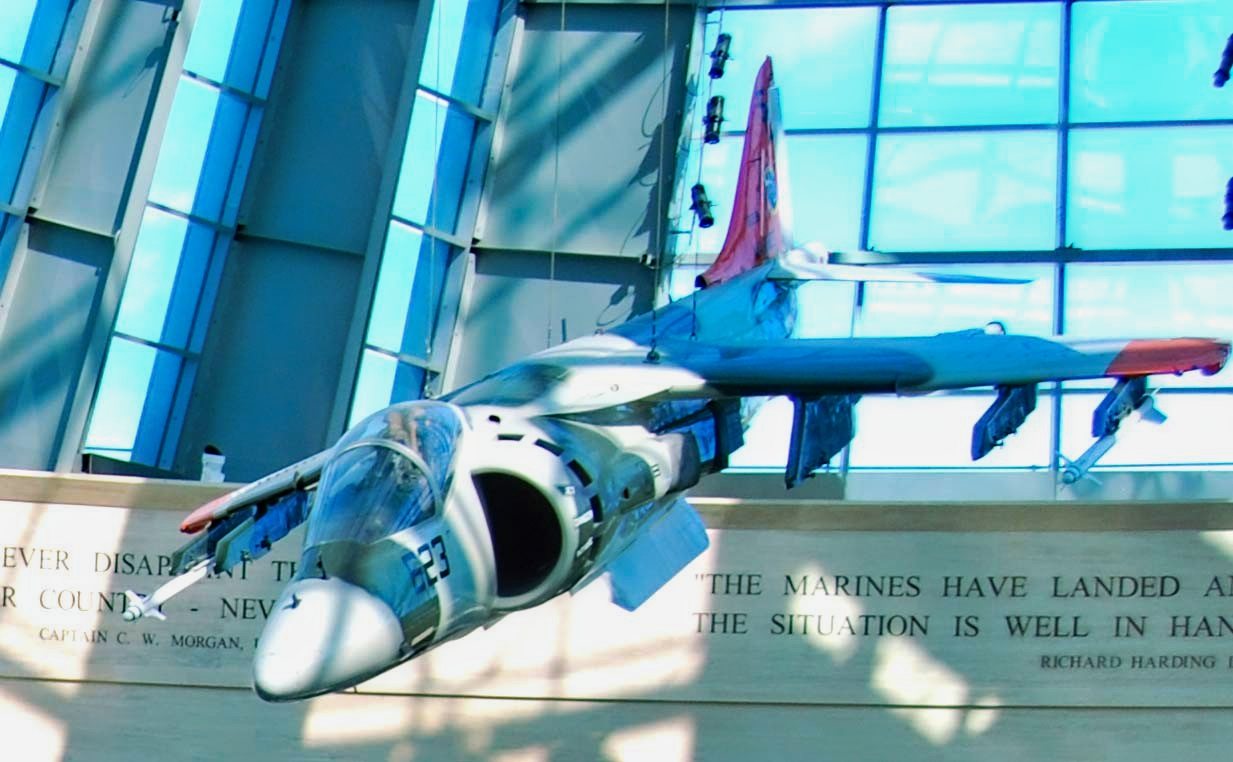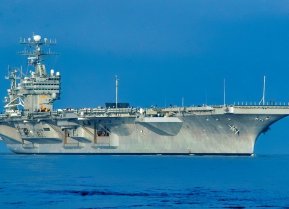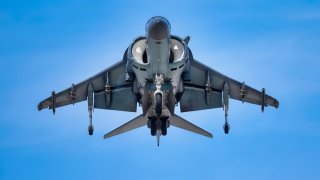Before the F-35, the AV-8B Harrier II was the King of the Sky
The AV-8B Harrier II was as much a "star" of the 1994 film True Lies as Arnold Schwarzenegger or Jamie Lee Curtis – and it also was the aircraft that literally saved humanity in the lackluster 2000 film Battlefield Earth.
The AV-8B Harrier II was as much a "star" of the 1994 film True Lies as Arnold Schwarzenegger or Jamie Lee Curtis – and it also was the aircraft that literally saved humanity in the lackluster 2000 film Battlefield Earth.
Back in reality, the McDonnell Douglas AV-8B Harrier II saw extensive use with the United States Marine Corps, including in combat operations in Afghanistan and Iraq.
Capable of vertical or short takeoff and landing (V/STOL), the AV-8B Harrier II has been primarily employed on light attack or multi-role missions, ranging from close air support of ground troops to armed reconnaissance. In addition to service with the USMC, the Harrier II has been adopted by the Spanish Navy, and the Italian Navy for carrier-based operations.
A variant of the AV-8B, the British Aerospace Harrier II, was also developed for the British military – while the TAV-8B was produced as a dedicated two-seat trainer.
The Improved Harrier
There is considerable confusion around the AV-8B Harrier II being the first "successful" V/STOL aircraft. In fact, the single-engine ground-attack aircraft constituted the second generation of the Harrier family. It aimed at addressing the operational inadequacies of the first-generation Hawker Siddeley Harrier developed in the 1960s.
The primary issue with the aircraft – designated the AV-8A by the Marine Corps, which first procured the Harrier in 1968 – was that it was handicapped in range and payload, able to carry less than half the 4,000 pounds (1,800 kg) payload of the smaller A-4 Skyhawk and over a more limited radius.
After gathering experience with the aircraft, the USMC sought to take the UK's first-generation Harrier design and made it a far more capable warbird – the AV-16A Advanced Harrier. It began as a joint project between McDonnell Douglas (now part of Boeing) and British Aerospace before the British government pulled out of the project in March 1975.
That could have been the end of the story for the aircraft, but building on technical accomplishments of the joint program, McDonnell Douglas revised its design configuration, incorporating an all-new composite structure wing that was larger (with 14.5 percent more area and 20 percent greater span) and offered a supercritical aerofoil section. The design promised most of the AV-16's capabilities but didn't require the new Rolls-Royce Pegasus engine that the project initially called for – and which was too large for the existing airframe.

However, the airframe was still upgraded, making greater use of carbon-fiber materials while the new cockpit was based around hands-on throttle and stick (HOTAS) controls. Additional aerodynamic devices were further added to improve life and load carrying.
The AV-8B Harrier II is Born
The initial YA-8B service test aircraft – essentially a reworked AV-8A – had its first test flight in November 1978. Thanks to the new wing design, which also possessed a reduced leading edge seep, the aircraft was able to support six hardpoints. Moreover, its carbon-fiber structure along with more efficient air intakes and additional carbon-fiber fuselage trimmed the weight of the aircraft.
Even as it was still being developed, the McDonnell Douglas AV-8B Harrier II was in the crosshairs of a potentially powerful enemy – the United States Navy, which had traditionally procured military aircraft for the Marine Corps. Between 1978 and 1980, officials in the U.S. Navy as well as the Department of Defense (DoD) sought to terminate the program. The U.S. Navy, which wanted to procure the A-18 for its ground attack force, had pressured the Marine Corps to adopt a similarly designed F-18 fighter. Eventually, the capabilities were amalgamated to create the multirole F/A-18 Hornet – yet, the DoD did eventually include the Harrier II in its annual budget and five-year defense plan.
Four pre-production AV-8Bs began testing with the United States Marine Corps in November 1981, and that paved the way for the first production delivery in 1983. The four pre-production aircraft, along with the first dozen production models were powered by the F402-RR-404 engine before it was superseded by the 95.42kN thrust F402-RR-406, which was equivalent to the Pegasus Mk 105. That engine was updated in later models with the F402-RR-408. Compared to earlier Harriers, the AV-8B's cockpit offered a much-improved field of vision thanks to a single-piece wraparound bubble canopy.
The Harrier II could deploy a wide range of weapon systems, including the air-to-air AMRAAM and Sparrow missiles, air-to-surface AGM-65 Maverick missiles, anti-ship Harpoon and Sea Eagle missiles, a 25mm cannon, and a range of bombs and rockets.
From the 167th airframe, the AV-8Bs were delivered in the "Night Attack" standard, which included a forward-looking infrared (FLIR) sensor, an improved head-up display, a head-down display, and a color-moving map. The first Night Attack Harrier II was delivered to Marine Fighter Attack Squadron 214 (VMA-214) "The Black Sheep" in September 1989 and the aircraft saw operational service during Operation Desert Storm, in the course of which seven aircraft were lost.
U.S. Army General Norman Schwarzkopf named the AV-8B Harrier II as one of several important weapons in the 1991 Gulf War.
The aircraft later served in Operation Enduring Freedom in Afghanistan, the Iraq War (2003-2011), the subsequent War in Iraq (2013-2017), and Operation Odyssey Dawn in Libya in 2011.
The AV-8B was routinely deployed onboard amphibious assault ships and simple forward operating bases.
In total, production for the United States Marine Corps extended to 280 aircraft, while a total of 340 aircraft were manufactured including for foreign sales before the production ended in 2003.
Peter Suciu: Author Experience and Expertise
Peter Suciu is a Michigan-based writer. He has contributed to more than four dozen magazines, newspapers, and websites with over 3,200 published pieces over a twenty-year career in journalism. He regularly writes about military hardware, firearms history, cybersecurity, politics, and international affairs. Peter is also a Contributing Writer for Forbes and Clearance Jobs. You can follow him on Twitter: @PeterSuciu.
Email the author: [email protected].


